株式市場はどのように機能するのでしょうか?
主な学習目標:
導入: This section explores the workings of the stock market, including the distinction between
exchanges and OTC markets, the concept of fractional ownership, and the dynamics of stock pricing.
Understanding these fundamentals is key to effective participation in stock trading.
1. Distinguish between Exchanges and OTC Markets: Understand the key differences,
benefits, and disadvantages of both.
2. Comprehend the Concept of Fractional Ownership: Learn how buying a stock means
buying a fraction of a company and the implications of such ownership.
3. Master the Dynamics of Stock Pricing: Understand how supply and demand, along with
various external factors, impact the price of stocks.

形: A dynamic representation of the stock market with fluctuating graphs, numbers, and symbols. The image encapsulates the volatile nature of stock trading and the intricacies of market analysis.
ソース: iStock写真
In this section, we’ll dive deeper into the inner workings of the stock market, discussing key topics like how the market operates, the concept of fractional ownership, and the different ways to make money through stocks. By the end of this section, you’ll have a solid understanding of these concepts, enabling you to make better-informed investment decisions.
3.1 How Does the Stock Market Work? Exchanges vs. OTC Market
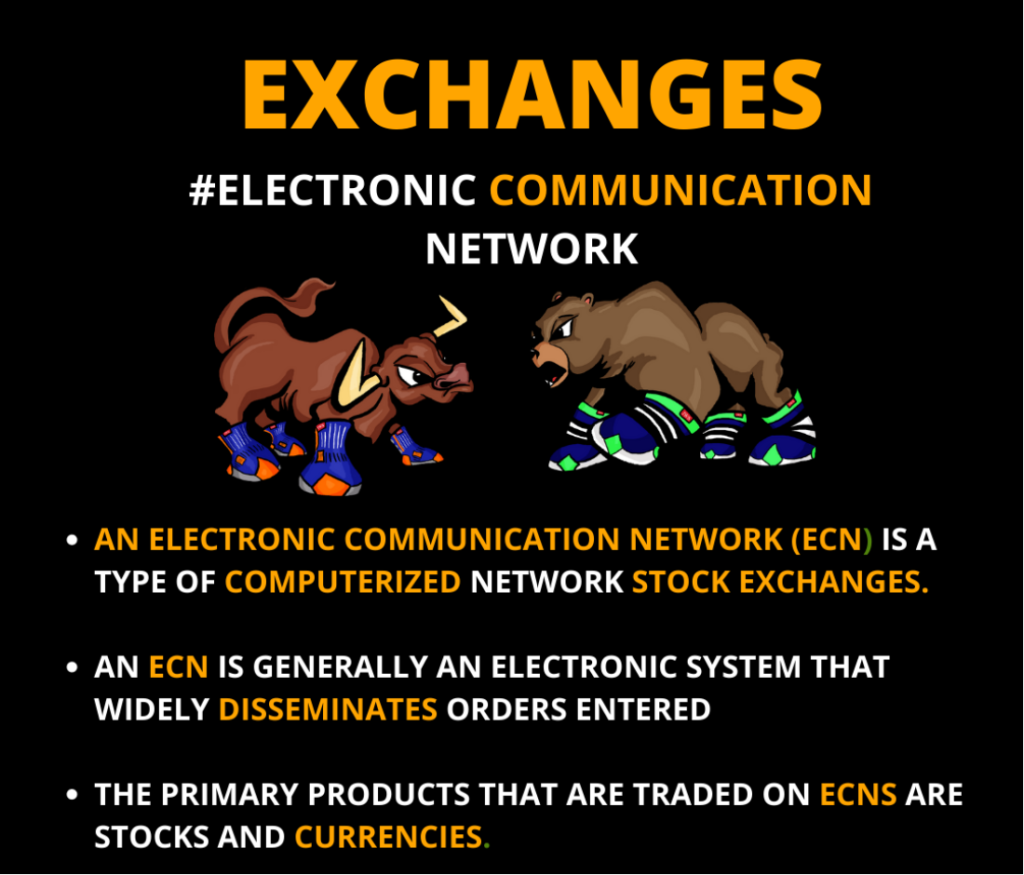
形: The infographic provides insights into “Electronic Communication Networks (ECNs)” in the context of stock exchanges. ECNs are computerized networks used for stock exchanges, which disseminate orders entered widely. The primary products traded on ECNs include stocks and currencies. Understanding ECNs can be crucial for traders and investors who wish to navigate the digital landscape of stock trading efficiently.
出典: カスタム インフォグラフィック
The stock market is made up of various exchanges, such as the New York Stock Exchange (NYSE) and the NASDAQ, where stocks are listed and traded. Companies that list their stocks on an exchange must meet specific requirements, such as minimum market capitalization, revenue, and trading volume. Being listed on an exchange offers several benefits, including increased visibility, access to capital, and a wider investor base. The disadvantage to being listed on an exchange is the increased cost associated with filing for a public company.
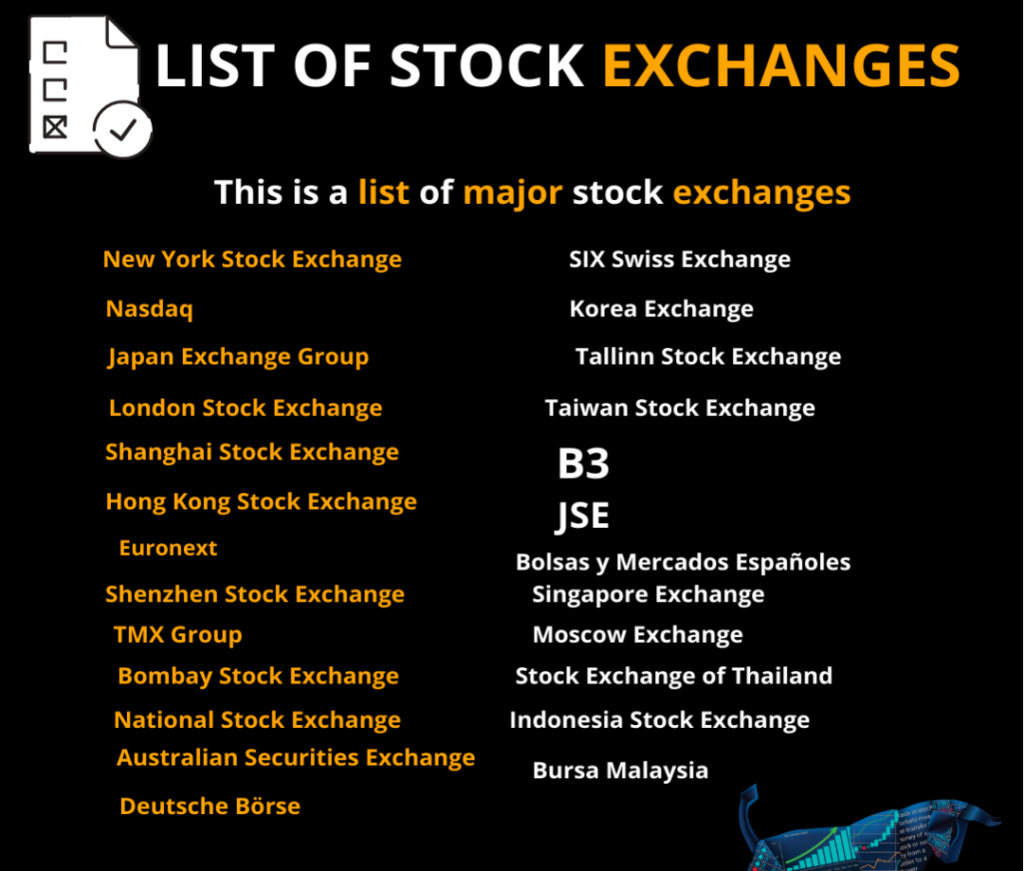
形: The infographic presents a comprehensive “List of Stock Exchanges” from around the world. Major stock exchanges such as the New York Stock Exchange, Nasdaq, Japan Exchange Group, and London Stock Exchange are highlighted, among others. This list serves as a valuable reference for investors and traders looking to diversify their portfolios across different global markets.
出典: カスタム インフォグラフィック
On the other hand, the Over-the-Counter (OTC) market is a decentralized platform where stocks not listed on a formal exchange are traded. These stocks typically belong to smaller companies that do not meet the requirements of major exchanges. OTC trading has fewer regulations and can be riskier, but it provides an opportunity for investors to discover undervalued or undiscovered companies.
Different exchanges cater to different types of stocks. For example, the NASDAQ is known for technology stocks, while the London Stock Exchange (LSE) is a hub for international companies.
3.2 Stocks as Fractional Ownership
When you buy a share of a company, you are essentially purchasing a small fraction of ownership in that company. This entitles you to a share of the company’s assets and future earnings. As a shareholder, you may also have voting rights, allowing you to participate in important corporate decisions.
Ways of Making Money in the Stock Market: Capital Appreciation & Dividends
There are two primary ways to make money in the stock market:
- 資本の評価増: This occurs when the value of a stock increases, allowing you to sell your shares at a higher price than what you initially paid. For example, if you bought a stock for $50 and its price increased to $75, your capital appreciation would be $25 per share.
- 配当金: Some companies distribute a portion of their earnings to shareholders in the form of dividends, providing a steady income stream. For instance, if a company pays a $1 dividend per share and you own 100 shares, you would receive $100 in dividends.
It’s important to note that some stocks offer both capital appreciation and dividends, providing multiple avenues for potential returns.
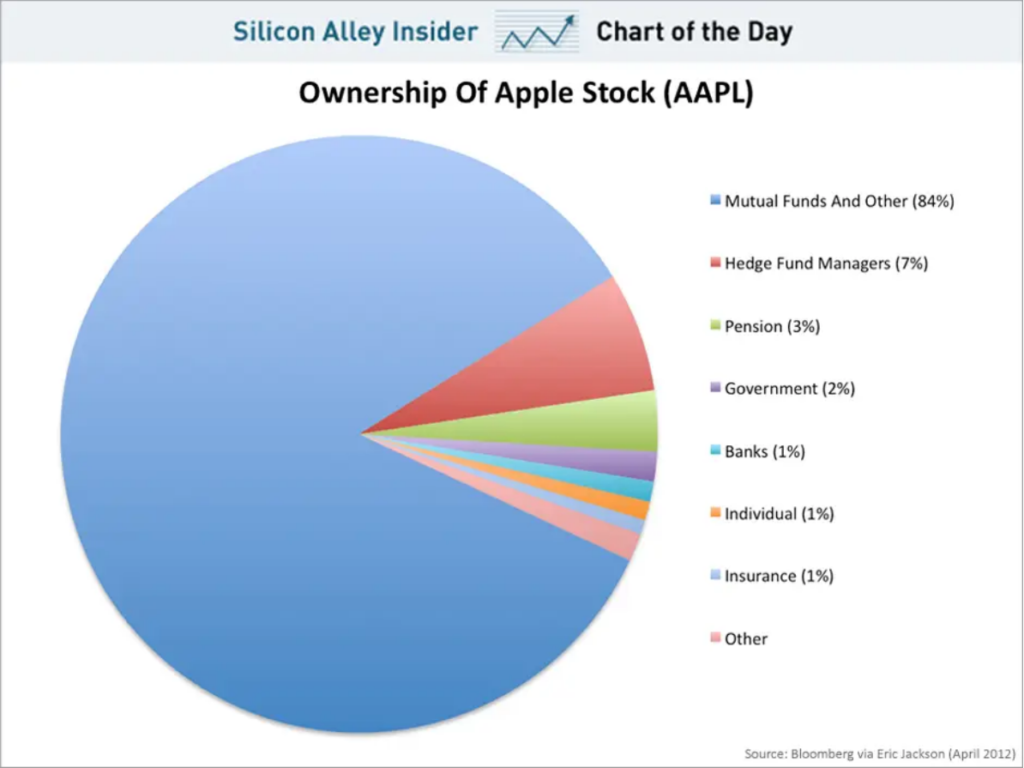
Figure Title: Apple’s Stock Ownership Breakdown in 2012
ソース: ビジネスインサイダー
説明: The pie graph illustrates the breakdown of Apple’s stock ownership in 2012, indicating how the company’s ownership is distributed among various market participants. The segments represent different groups of shareholders, including mutual funds, hedge funds, government entities, banks, individuals, insurance companies, and others such as retail investors. Each segment’s size represents the proportion of Apple’s outstanding shares held by that specific category of market participant.
Expanding the Concept: When an individual buys a stock, it signifies acquiring a fractional ownership stake in the company. By holding a share, an investor becomes a partial owner and is entitled to a proportional claim on the company’s assets, earnings, and voting rights. This concept can be extended to understand that owning a stock is equivalent to holding a piece of the company’s overall value, and the value of that ownership is directly influenced by the company’s financial performance and market dynamics.
重要なポイント:
- Fractional Ownership: The graph demonstrates the principle of fractional ownership. Each slice of the pie represents a specific share in the company, indicating that when investors buy Apple’s stock, they become fractional owners with a proportional claim to its value and profits.
- Diverse Shareholders: The diversified breakdown of Apple’s stock ownership highlights the diverse range of participants in the stock market. This includes institutional investors, individual retail investors, insurance companies, government entities, banks, and more, each contributing to the company’s overall ownership structure.
- Market Influence: The varying interests of different shareholders can impact the company’s strategic decisions and corporate governance. Larger stakeholders, such as institutional investors and mutual funds, may have more influence in company affairs due to their significant ownership positions.
- Investment Implications: Recognizing that stocks represent partial ownership can influence investment decisions. Investors need to analyze a company’s financial health, performance, and management to make informed choices about buying, holding, or selling stocks.
応用: Understanding the concept of fractional ownership is crucial for investors to comprehend the dynamics of the stock market. By recognizing that owning shares represents a stake in the company, investors can view their stock investments as long-term partnerships with the business. This perspective encourages investors to focus on the company’s fundamentals and prospects, rather than being swayed solely by short-term market fluctuations. Additionally, understanding the diverse composition of stock ownership aids investors in comprehending how the actions and decisions of various market participants can influence stock prices and overall market sentiment.
3.3 Companies, Supply, and Demand for Stock: How Does It Affect Price?
The price of a stock is determined by the supply and demand for that stock in the market. Various factors can influence the demand for a stock, causing its price to rise or fall.

形: The infographic emphasizes the importance of understanding one’s investments with a prominent quote: “Invest only in companies you understand.” It further elaborates with advice, “Buy a stock the way you would buy a house. Understand and like it such that you’d be content to own it in the absence of any market.” This guidance underscores the significance of thorough research and confidence in one’s investment choices.
出典: カスタム インフォグラフィック
10 Reasons Why Demand for a Company’s Stock Would Decrease:
- 財務実績の低さ
- ネガティブなニュースやスキャンダル
- 市場全体またはセクター全体の衰退
- 競争の激化
- 規制上の問題または法的課題
- Disappointing product launches
- Loss of key personnel
- Economic downturn
- Rising interest rates
- Geopolitical tensions

形: The infographic emphasizes the significance of investing in quality over price with a notable quote: “It’s far better to buy a wonderful company at a fair price, than a fair company at a wonderful price.” This advice underscores the importance of prioritizing the intrinsic value and potential of a company over just the stock price.
出典: カスタム インフォグラフィック
10 Reasons Why Demand for a Company’s Stock Could Increase:
- Strong financial performance
- Positive news or industry developments
- A growing market or sector
- Successful product launches or innovations
- Expansion into new markets
- Strategic acquisitions or partnerships
- Dividend increases or stock buybacks
- Attractive valuation
- Favorable economic conditions
- Decreasing interest rates
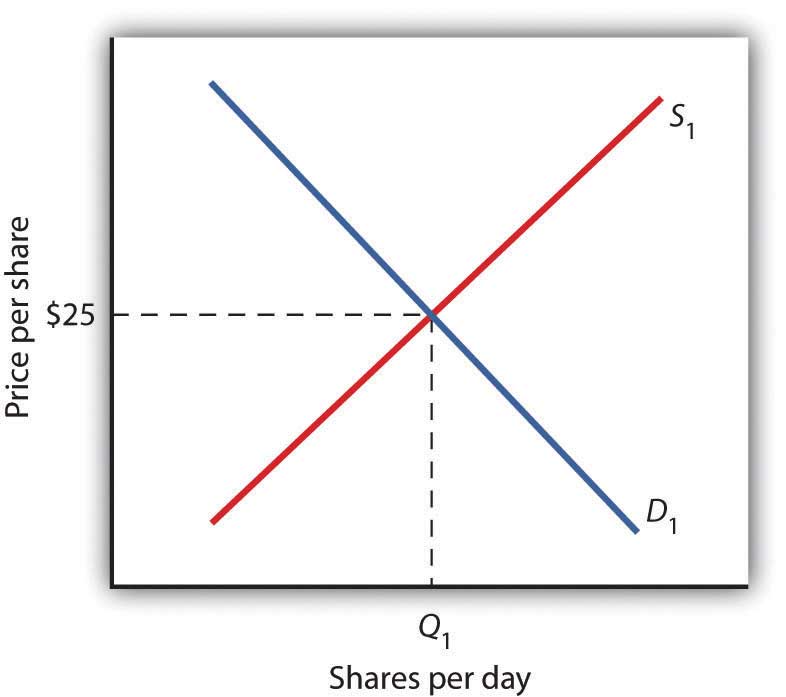
図のタイトル: Equilibrium Price of Intel Corporation Stock Shares Based on Demand and Supply
ソース: University of Minnesota Libraries
説明: The graph illustrates the supply (S1) and demand (D1) dynamics for Intel Corporation stock shares. The equilibrium price, where the supply and demand curves intersect, is at $25. At this price, Q1 million shares are exchanged every day. Neither a surplus nor a shortage exists at this equilibrium point since the quantity demanded equals the quantity supplied.
重要なポイント:
- Equilibrium Price: At a price of $25, both buyers are willing to purchase, and sellers are prepared to sell Q1 million shares, ensuring a stable market.
- Role of Supply and Demand Curves: The position and shape of these curves determine the equilibrium price and quantity. Any shift in these curves can result in changes in equilibrium.
- 市場動向: If the demand for Intel Corporation shares were to increase, the demand curve would shift to the right, raising the equilibrium price. Conversely, if the supply of shares increases, the supply curve shifts right, reducing the equilibrium price.
応用: Supply and demand charts, like the one presented, are foundational tools for investors and analysts to understand market dynamics. Recognizing how factors can shift these curves helps in anticipating price movements. In the context of stock investing, such insights can be particularly valuable in making buying or selling decisions. For instance, if there were news or data suggesting a potential increase in demand for Intel shares (e.g., groundbreaking product announcement), an investor might anticipate a rightward shift in the demand curve and a resultant rise in stock prices.
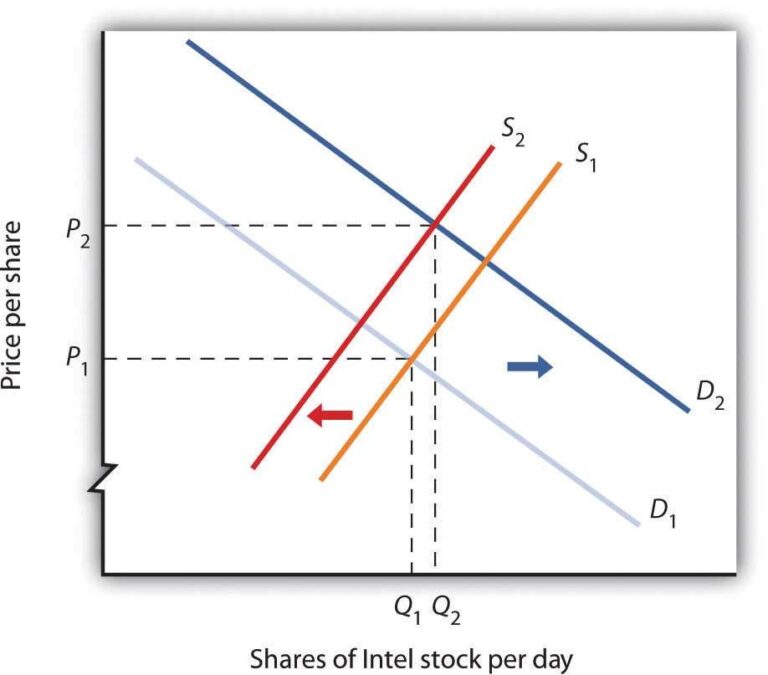
Figure Title: Shifts in Supply and Demand, Effect on Price
ソース: University of Minnesota Libraries
説明: The graph visualizes how changes in supply and demand can impact the equilibrium price of an asset.
In the depicted scenario:
- Decrease in Supply: The supply curve shifts leftward from S1 to S2. All else being constant, this reduction in supply causes the equilibrium price to increase.
- Increase in Demand: The demand curve shifts rightward from D1 to D2. This increase in demand also leads to a rise in the equilibrium price.
When both these shifts occur simultaneously, the equilibrium price is likely to rise even more significantly.
重要なポイント:
- Supply Curve Shift: A decrease in supply (from S1 to S2) indicates that fewer units of the asset are available at every price point. It might be due to production issues, increased production costs, or other external factors. The reduced availability causes prices to rise to balance out the limited supply with the existing demand.
- Demand Curve Shift: An increase in demand (from D1 to D2) signifies that consumers are now willing to buy more of the asset at each price point. It might be because of increased consumer preference, a rise in an underlying need, or positive news about the asset. With demand surpassing the original supply, prices will increase until a new equilibrium is reached.
- Combined Effect: When supply decreases and demand increases simultaneously, the resultant effect on price is compounded. It means that the price will likely rise by a higher margin than if only one of the shifts occurred.
応用: Supply and demand charts, like the one mentioned, are fundamental in understanding market dynamics. Any event or information that can cause shifts in these curves can lead to price fluctuations. Being able to predict or understand such shifts gives investors, policymakers, and businesses insights into price movements and helps in decision-making.
For example, in real-world scenarios, if there’s sudden positive news about a technology company (maybe they announced a revolutionary product), the demand for their stocks might increase. If, at the same time, there’s limited availability of shares in the market, the combined effect would significantly push the stock prices up.
重要なポイント:
重要なポイント:
Closing Statement: The mechanics of stock market operations, the essence of fractional ownership, and
the dynamics of stock pricing are crucial knowledge areas for anyone looking to navigate the stock
market efficiently. This section lays the groundwork for a deeper understanding of market operations,
aiding in making informed investment decisions.
1. The stock market comprises various exchanges, like NYSE and NASDAQ, and the
decentralized OTC market; each has its own listing requirements and target companies.
2. Owning a stock means owning a fraction of the company, entitling you to its assets, future
earnings, and possibly voting rights.
3. The price of a stock is majorly determined by its supply and demand in the market, and
numerous factors, both positive and negative, can influence this demand.
